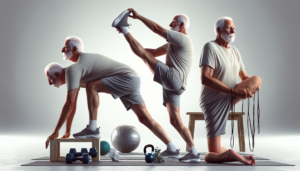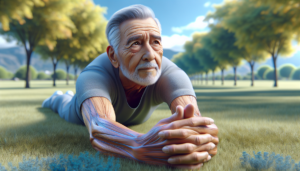Importance of Exercise for Older Men
As an older man looking to improve joint health, reduce stiffness, and increase overall mobility, senior men’s fitness tips play a vital role in enhancing your well-being. Let’s explore the benefits of physical activity and the risks associated with a sedentary lifestyle tailored specifically for older men.
Benefits of Physical Activity
Engaging in regular physical activity as a senior man can significantly impact your overall health and quality of life. Physical exercises help to maintain strength, agility, and independence, supporting functions that are essential for daily activities. According to MyPlate.gov, being physically active can help senior men stay strong and independent. The various benefits of physical activity include:
- Brain Function: Physical activity is linked to improved cognitive function and can help maintain mental sharpness as you age.
- Balance: Regular exercise can improve balance and coordination, reducing the risk of falls and related injuries.
- Bone Strength: Weight-bearing exercises help maintain bone density and reduce the risk of osteoporosis.
By incorporating exercise into your routine, you can enhance your physical health, mental well-being, and overall quality of life. Check out our senior fitness flexibility exercises for tailored workout plans to get you started.
Risks of a Sedentary Lifestyle
Leading a sedentary lifestyle can pose significant health risks for older men. Lack of physical activity can contribute to various health issues and diminish overall well-being. It’s essential to understand the potential risks associated with a sedentary lifestyle to motivate you to maintain an active routine. Key risks include:
- Increased Risk of Chronic Diseases: Sedentary behavior is associated with a higher risk of chronic conditions such as heart disease, diabetes, and osteoporosis.
- Loss of Muscle Mass: Inactivity can lead to muscle loss and decreased strength, impacting mobility and independence.
- Mental Health Concerns: Sedentary behavior is linked to an increased risk of depression, anxiety, and cognitive decline.
By staying physically active, you can mitigate these risks and enhance your overall health and longevity. Adopting a more active lifestyle can help prevent disease and improve your quality of life. Explore our senior male mobility routine to discover engaging exercises tailored to your age and fitness level.
Regular exercise is not only beneficial for physical health but also promotes mental well-being and independence as you age. By incorporating fitness into your routine, you can enjoy a more active and fulfilling lifestyle while reducing the risks associated with inactivity.
Injury Prevention Strategies
As I delve into the realm of senior men’s fitness and flexibility & mobility, adopting injury prevention strategies becomes paramount to maintaining a safe and effective exercise routine. Here, I will focus on the significance of proper form, the importance of warm-up techniques, and how the choice of footwear can impact your workout sessions.
Importance of Proper Form
When engaging in physical activities, especially as we age, maintaining proper form and technique is crucial for preventing injuries. Improper form can lead to serious issues such as rotator cuff tears and lower back strain, particularly during strength training routines. Ensuring that you have the correct posture and alignment during exercises helps distribute the workload across the appropriate muscle groups and reduces the strain on vulnerable areas of your body.
Warm-up Techniques
Before embarking on any exercise regimen, incorporating adequate warm-up techniques is essential for older men. Warm-up exercises help increase blood flow, improve tissue elasticity, and prepare the nervous system for the upcoming workout. As we age and our soft tissues become less elastic, a proper warm-up becomes even more critical in preventing injuries (AARP). By allowing the body to gradually transition from rest to activity, warm-up exercises reduce the risk of strains, sprains, and muscle tears.
Impact of Footwear Choice
Selecting the right footwear for your workout sessions is often an overlooked aspect of injury prevention. Wearing the wrong shoes can lead to discomfort, pain, and even injuries. It’s essential to opt for shoes specifically designed for your chosen physical activity, ensuring they provide adequate support and cushioning. Additionally, proper fit is crucial to prevent blisters, calluses, and other foot issues that can hinder your workouts. Experts recommend replacing workout shoes after approximately 100 miles of use and rotating between multiple pairs to lower the risk of injury (AARP).
As older adults, our bodies undergo natural changes that can increase the risk of exercise-related injuries. Factors like bone, joint, tendon, and muscle loss, coupled with lifestyle choices, can accelerate this process, making it even more important to prioritize injury prevention strategies as we engage in physical activity (Temple Health). By emphasizing proper form, incorporating effective warm-up techniques, and choosing appropriate footwear, you can safeguard your fitness journey and enjoy the benefits of staying active in your golden years.
Fitness Tips for Older Men
As I embark on the journey of improving my fitness in my golden years, there are several key considerations that can help me maintain vitality and mobility. In this section, we will explore the benefits of cross-training, the importance of incorporating strength training, and the dietary considerations essential for senior men’s fitness.
Cross-training Benefits
Cross-training offers a comprehensive approach to fitness by engaging in a variety of exercises that target different muscle groups and movement patterns. This method not only reduces the risk of overuse injuries but also enhances overall strength, endurance, and flexibility. By mixing activities such as swimming, cycling, and yoga, I can improve my cardiovascular health, strengthen muscles, and enhance my range of motion, all crucial for maintaining optimal fitness levels as I age.
Incorporating cross-training into my fitness routine can also provide mental stimulation and prevent boredom, making it more likely for me to stay committed to regular physical activity. To discover specific stretching routines and exercises tailored for seniors, consider exploring stretching routines for seniors to add variety and challenge to your workouts.
Incorporating Strength Training
Strength training is a cornerstone of senior men’s fitness, aiding in the preservation of muscle mass, bone density, and joint health. By incorporating exercises like bodyweight squats, lunges, and resistance band curls into my routine, I can build strength and improve balance, reducing the risk of falls and enhancing overall functional ability.
Embracing a senior male flexibility program that includes strength training exercises not only improves physical performance but also promotes independence and quality of life. Remember to prioritize proper form, gradually increase weights, and allow for adequate rest between sessions to maximize the benefits of strength training while minimizing the risk of injury.
Dietary Considerations
Fueling my body with the right nutrients is essential for supporting my fitness goals and overall well-being. Making small changes to my daily eating habits, like incorporating whole grains, drinking plenty of water, and opting for healthier cooking alternatives, can contribute to improved health outcomes for senior men (MyPlate.gov).
Maintaining adequate protein intake is crucial for building and repairing muscles, especially as I age. Good sources of protein include meats, fish, eggs, dairy, soy products, beans, nuts, and seeds. Distributing protein intake throughout the day can optimize its benefits for muscle health and function. Additionally, vitamin D plays a vital role in maintaining healthy bones and can be sourced from sun exposure or foods like egg yolks, dairy, and fish. Consider incorporating weight-bearing exercises into your routine to further support bone health and overall fitness.
By incorporating cross-training, strength training, and mindful dietary choices into my fitness regimen, I can optimize my physical well-being and enjoy a vibrant and active lifestyle in my golden years. Remember, consistency and perseverance are key to reaping the benefits of these fitness tips for older men.
Understanding Injury Risks
As I continue my fitness journey and strive to improve joint health and mobility, it’s crucial to be aware of the unique challenges that come with aging. Understanding the physiological changes that occur as we get older and identifying the factors that contribute to injuries can help me exercise safely and effectively. Let’s delve into these critical aspects.
Physiological Changes with Aging
As we age, our bodies undergo various physiological changes that can impact our ability to engage in physical activity safely. According to Temple Health, most people begin to experience bone, joint, tendon, and muscle loss in their mid-40s to early 50s. Factors like a small body frame, smoking history, or heavy alcohol use can accelerate this loss, making exercise-related injuries more likely for older adults.
Additionally, older middle-aged individuals and beyond may experience slower healing from injuries due to increased inflammation, less efficient cell repair, and hormone changes (Temple Health). These physiological changes emphasize the importance of taking a proactive approach to injury prevention and adopting exercise routines that cater to the specific needs of aging bodies.
Factors Contributing to Injuries
It’s essential to recognize the factors that can contribute to injuries in older adults, particularly during physical activities. Adults aged 50 and over are more prone to exercise-related injuries compared to younger adults, highlighting the need for caution and mindfulness during workouts.
Common issues faced by older individuals include falls due to balance issues, joint inflammation, stiffness, and tendons becoming more prone to tearing. These challenges underscore the importance of incorporating injury prevention strategies into my fitness routine to reduce the risk of setbacks and maintain my overall health and well-being.
By being mindful of the physiological changes associated with aging and understanding the factors that can contribute to injuries, I can tailor my exercise regimen to mitigate risks and enhance the benefits of physical activity. Stay tuned for more insights on how I can optimize my fitness journey and prioritize the health of my joints and muscles as I embrace my golden years.
Maintaining Joint Health
As we age, it becomes increasingly important to prioritize our joint health to reduce stiffness, improve mobility, and enhance overall quality of life. Incorporating flexibility exercises, focusing on balance, and incorporating endurance training are key aspects of maintaining joint health as we grow older.
Benefits of Flexibility Exercises
Flexibility exercises play a vital role in enhancing joint mobility and reducing the risk of injuries. Stretching routines help to maintain the elasticity of muscles and tendons, improving overall flexibility and range of motion. By incorporating stretching routines for seniors into your fitness regimen, you can alleviate muscle tension, prevent muscular imbalances, and enhance your overall mobility.
Importance of Balance
Balance is a critical component of joint health, particularly for older adults. Integrating balance exercises into your fitness routine not only helps improve stability and coordination but also reduces the risk of falls. The Berg Balance Scale is a useful tool for assessing balance, with scores indicating different fall risk levels. By focusing on balance, you can enhance your confidence in everyday movements and maintain your independence.
Role of Endurance Training
Endurance training, such as aerobic exercises and cardio activities, offers numerous benefits for joint health in older men. Endurance exercises have been shown to improve cardiovascular performance, increase peak oxygen consumption (VO2), and enhance parameters like heart rate recovery (NCBI). By engaging in regular endurance training, you can boost your stamina, enhance heart health, and support joint function.
Incorporating a well-rounded fitness routine that includes flexibility exercises, balance training, and endurance activities is essential for preserving joint health and promoting overall well-being. By staying active and focusing on these key elements, you can enhance your mobility, reduce the risk of falls, and enjoy a more active and fulfilling lifestyle. Explore flexibility exercises for older men and mobility workouts for older men to tailor your fitness regimen to support optimal joint health.
Recommendations for Senior Fitness
As we embrace our golden years, prioritizing fitness becomes essential to maintain vitality and overall well-being. Let’s explore key recommendations for senior men to enhance their fitness levels and promote joint health.
Aerobic Exercise Guidelines
Engaging in regular aerobic exercise has numerous benefits for older adults. It helps improve cardiovascular health, increase endurance, and support joint health (Cleveland Clinic). Here are some important aerobic exercise guidelines for senior men:
| Exercise Type | Frequency | Duration |
|---|---|---|
| Brisk Walking | 5 days a week | 30 minutes per session |
| Cycling | 3 days a week | 20-30 minutes per session |
| Swimming | 2-3 days a week | 20-30 minutes per session |
Incorporating a variety of aerobic activities can help you stay active, boost your mood, and improve overall cardiovascular fitness.
Strength Training Recommendations
Strength training is crucial for older men to maintain muscle mass, bone density, and functional strength. It also plays a key role in preventing age-related muscle loss. Here are some strength training recommendations tailored for senior men:
| Exercise | Sets | Repetitions | Rest Between Sets |
|---|---|---|---|
| Squats | 2-3 | 10-15 | 60 seconds |
| Chest Press | 2-3 | 10-12 | 60 seconds |
| Leg Press | 2-3 | 12-15 | 60 seconds |
By incorporating strength training into your fitness routine, you can improve muscle strength, support joint stability, and enhance overall physical function.
Importance of Balance and Flexibility
Balance and flexibility are key components of senior fitness, helping prevent falls, improve coordination, and maintain mobility (NCBI). Here’s why focusing on balance and flexibility is crucial for older men:
- Balance Exercises: Performing balance exercises, such as standing on one leg or heel-to-toe walking, can enhance proprioception and stability.
- Flexibility Exercises: Engaging in regular stretching routines can improve range of motion, reduce stiffness, and prevent injury.
By incorporating balance and flexibility exercises into your fitness regimen, you can enhance your overall mobility, reduce the risk of falls, and enjoy a more active lifestyle.
Ensuring a well-rounded fitness routine that includes aerobic exercise, strength training, and activities to boost balance and flexibility is essential for senior men looking to maintain their health, improve joint function, and enhance overall vitality. Remember, it’s never too late to start your fitness journey and reap the countless benefits of staying active and healthy as you age.



